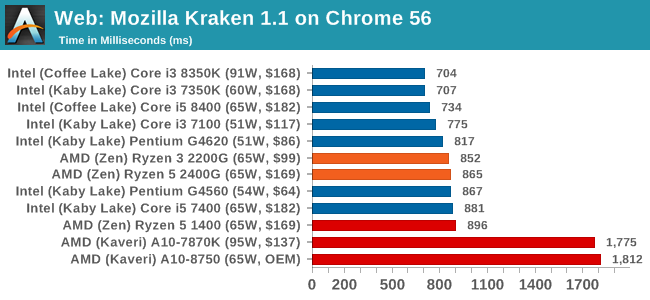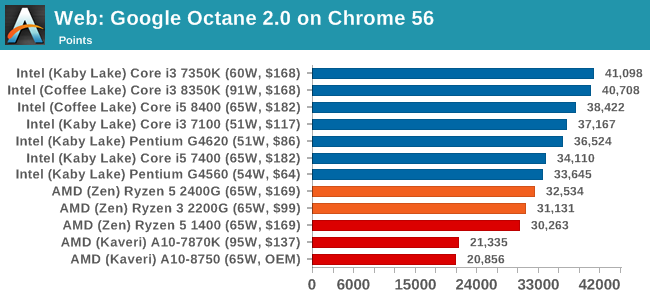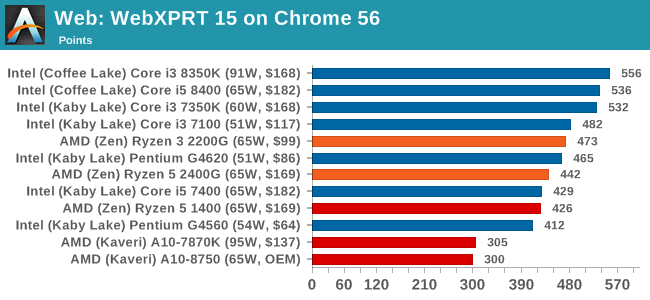Marrying Vega and Zen: The AMD Ryzen 5 2400G Review
by Ian Cutress on February 12, 2018 9:00 AM ESTBenchmarking Performance: CPU Web Tests
One of the issues when running web-based tests is the nature of modern browsers to automatically install updates. This means any sustained period of benchmarking will invariably fall foul of the 'it's updated beyond the state of comparison' rule, especially when browsers will update if you give them half a second to think about it. Despite this, we were able to find a series of commands to create an un-updatable version of Chrome 56 for our 2017 test suite. While this means we might not be on the bleeding edge of the latest browser, it makes the scores between CPUs comparable.
All of our benchmark results can also be found in our benchmark engine, Bench.
Mozilla Kraken 1.1: link
Kraken is a Javascript based benchmark, using the same test harness as SunSpider, but focusing on more stringent real-world use cases and libraries, such as audio processing and image filters. Again, the basic test is looped ten times, and we run the basic test four times.

With the newer high-performance cores, AMD gets a fair crack at benchmarks like Mozilla, where it historically lagged behind with its Bulldozer-family architecture.
Google Octane 2.0: link
Along with Mozilla, as Google is a major browser developer, having peak JS performance is typically a critical asset when comparing against the other OS developers. In the same way that SunSpider is a very early JS benchmark, and Kraken is a bit newer, Octane aims to be more relevant to real workloads, especially in power constrained devices such as smartphones and tablets.

In recent years, Intel has made strides on its Octane performance. So even with cores and threads, and the sizable jump up from Kaveri, AMD is still behind on this test.
WebXPRT 2015: link
While the previous three benchmarks do calculations in the background and represent a score, WebXPRT is designed to be a better interpretation of visual workloads that a professional user might have, such as browser based applications, graphing, image editing, sort/analysis, scientific analysis and financial tools.











177 Comments
View All Comments
Gonemad - Wednesday, February 14, 2018 - link
These chips will cause a major segment of low-end graphics cards to be buried, or have their prices cut down. I can't wait for the benchmarks, and see how many generations will be affected.callmesissi - Wednesday, February 14, 2018 - link
what an amazing apu... this makes all celerons / pentiums and half of i3 completely out of market! this apu is so good, so cheap, kills all the entry level gpus and basically all those intel cpus mentioned .way to go amd! now about those drivers and bios....
edlee - Thursday, February 15, 2018 - link
this is amazing by AMD, they need to keep the hits coming, and chipping away market share from intel. Intel has not made any progress on processor graphics in years, this is a super aggressive strategy by AMD that i think will work. Nvidia basically has to cancel out any gpu line below gtx 1030 by next year. Hopefully AMD comes out with a GTX 1050 killer by next year.CSMR - Wednesday, February 14, 2018 - link
I think the relevant Intel comparisons would be processors with Iris Pro or Iris Plus.Hixbot - Wednesday, February 14, 2018 - link
Do these APUs not compete directly with the new Intel-Vega chips? Why did AMD give Intel Vega, when AMD could have had the APU market all to themselves?SaturnusDK - Wednesday, February 14, 2018 - link
Not really. The i8809G as it's called is supposedly a mobile part if you can call a 100W TDP part mobile by any stretch of the imagination. It's based on a 22 (or 24) CU Vega and will be much much more expensive. Expect it to land somewhere in the $400+ range, ie. more expensive than an 8700Kfranco1961 - Thursday, February 15, 2018 - link
Hi Ian. Two questions: I have to do a cheap PC for video editing (Adobe Premiere, After Effcets, etc.) and I thought about a Ryzen 3 1200 and a Geforce GT 1030. You think this Ryzen 5 2400G goes for video editing by having a Vega 11? Another question: using DDR4 2400 would I have a strong performance drop or could it be okay? Thank you!rexian96 - Thursday, February 15, 2018 - link
A question for Ian or anyone who knows - Does 2400G not support HW encoding of H264/265 and just limited decoding? Or that Handbrake doesn't support it yet? Looking at the encoding score it would seem 8400 is miles ahead though the GPU in Ryzen is much stronger.csell - Friday, February 16, 2018 - link
Hi. Do you know the max videoram?Will it be possible to use Crossfire between the shared ram and a graphics card?
If crossfire will be limited to VEGA graphics card, will I hope AMD will introduce a cheap graphics card with just 8 or 11 Vega compute units and may be HDMI 2.0
SaturnusDK - Friday, February 16, 2018 - link
There will be no crossfire with dGPUs. It's no possible at all.